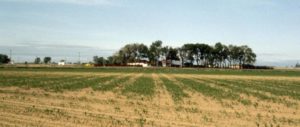Published December 8, 2020 | By Mike Petersen
I think everyone who have been reading PrecisionTillage.com have come to getting the idea that we at Orthman Manufacturing have a very reasonable grasp on the big issue surrounding soil compaction that pesters growers using larger and heavier equipment. Agronomic scientists and practioners from all over the globe, who study, evaluate compacted soils using penetrometers to assess the intensity or severity of dense soils is dealing with how to deal with the issue and how to minimize compactions effects. I know I continue to make strides to keep current and educate myself and the team here at Orthman regarding the limiting effects of soil compaction. Just in the last week I have come across some little known facts that I want to place in front of you.

Fig. 1: Heavy traffic prior to planting shows strong evidence of plant emergence that has been reduced consistently by seeing the traffic pattern
Where is it that soil density starts to impede (slow down) root elongation and penetration of the soil profile? Impedance is observed in the range of 1.2 to 2.0MPa (174 to 290psi) of resistance measured by cone penetrometers. Most plants we grow can easily create those kinds of force at the root tip when 70-85 days of age after emergence with adequate water resources being available. A question though comes to the forefront, what about when the corn, soybean, grain sorghum, cotton or peanut plant roots are less than 40 days after emergence? I say this because once roots encounter resistance in the soil above 2.0MPa, the root length can be decreased between 50 – 60% of normal growth and extension. Certain species like alfalfa have high energy levels and turgid pressures as well they are larger in diameter in the existing roots which I read in 10 different scientific papers provide the ability to penetrate more dense soils. When soil resistance exceeds 2.7MPa in maize root tip extension comes almost to a halt. It has been measured in young maize (corn) plants in greenhouse potted plant studies that at the root tip there can be at 35-40 days after emergence from 40 to 140 psi (≤1.0MPa) of force to extend roots into more dense soils to attain water and nutrients. When roots cannot press the root tip through dense soils they will deform or become more plastic to change axial directions and seek an existing biopore (old root channel) to continue elongation. Recent efforts in soil core studies with compacted layers and X-ray computer tomography technology, Nottingham University – U.K. determined that new roots will colonize (their term) old root biopores. Root tips are able to sense the change in oxygen levels from the pore and then grown downward many times co-mingling with other roots.
As we consider those kinds of values I believe we all should be taking a look in our fields before we pull the planters into the field next April for you folks in the Northern Hemisphere to gauge if any compaction is going to cause plant growth issues, water penetration and permeability of water into the deeper zones of your soil profiles. Then roots will get there too. Soil strength (compaction) is a leading major cause of inadequate rooting. It affects nearly all soil bio-physico-chemical properties such as soil porosity, water conductivity, microbial populations can be reduced (especially aerobic bacteria), plant resistance to disease or insects, and nutrient availability. Millions of acres (hectares) of agricultural lands are affected globally.
When root systems of corn for instance are retarded or held up to only explore and grow in the upper 20 – 24 inches of a soil profile, the water supply and nutrient supplies will be exhausted before the growing season is over. Thusly limiting total biomass that needs to be developed and yields of grain or forage will suffer.
In your tillage management thinking, prior to planting, if you are seeing evidence of compacted soils with less than desired plant stands, water runoff or ponding, ruts from harvest or spray rigs, purple looking corn early last season, stunting, floppy corn early in season, use of tandem disks when it was wet – look into the Conservation Tillage method of Strip Till. Compaction is almost every time man derived. But it does not mean a moldboard plow or a massive ripper tool is the answer to fix what happened. Check out us here at Orthman or a dealership that sells Orthman strip till implements, we would like to help, suggest and point your eyes in a direction of a very top notch Strip Tillage Systems approach.
From all of that in a quick summary, what is it that is new that we have not talked about before?
Impedance(in soils) when observed in the range of 1.2 to 2.0MPa (174 to 290psi) roots are dramatically slowed
Once roots encounter resistance in the soil above 2.0MPa, the root length can be decreased between 50 – 60% of normal growth and extension.
Recent efforts with compacted layers and X-ray computer tomography technology as roots attempt to penetrate compaction they can sense oxygen levels improve and change their tip growth direction to extend into a biopore, worm tunnel or old root cavity.
I will keep you up-to-date with new items on this website as I read, come across or learn new material. Do not hesitate to contact any of us when you see on the Home page of this website via the Contact tab.